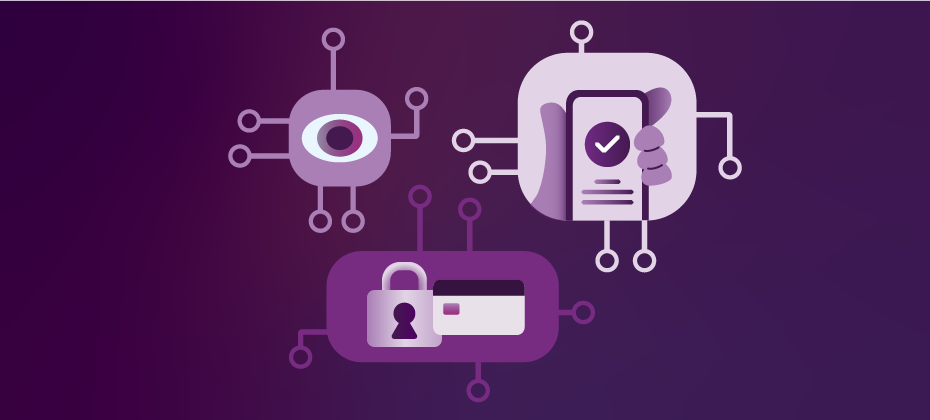Tag: fraud prevention

Fake IDs have been around for decades, but today’s fraudsters aren’t just printing counterfeit driver’s licenses — they’re using artificial intelligence (AI) to create synthetic identities. These AI fake IDs bypass traditional security checks, making it harder for businesses to distinguish real customers from fraudsters. To stay ahead, organizations need to rethink their fraud prevention solutions and invest in advanced tools to stop bad actors before they gain access. The growing threat of AI Fake IDs AI-generated IDs aren’t just a problem for bars and nightclubs; they’re a serious risk across industries. Fraudsters use AI to generate high-quality fake government-issued IDs, complete with real-looking holograms and barcodes. These fake IDs can be used to commit financial fraud, apply for loans or even launder money. Emerging services like OnlyFake are making AI-generated fake IDs accessible. For $15, users can generate realistic government-issued IDs that can bypass identity verification checks, including Know Your Customer (KYC) processes on major cryptocurrency exchanges.1 Who’s at risk? AI-driven identity fraud is a growing problem for: Financial services – Fraudsters use AI-generated IDs to open bank accounts, apply for loans and commit credit card fraud. Without strong identity verification and fraud detection, banks may unknowingly approve fraudulent applications. E-commerce and retail – Fake accounts enable fraudsters to make unauthorized purchases, exploit return policies and commit chargeback fraud. Businesses relying on outdated identity verification methods are especially vulnerable. Healthcare and insurance – Fraudsters use fake identities to access medical services, prescription drugs or insurance benefits, creating both financial and compliance risks. The rise of synthetic ID fraud Fraudsters don’t just stop at creating fake IDs — they take it a step further by combining real and fake information to create entirely new identities. This is known as synthetic ID fraud, a rapidly growing threat in the digital economy. Unlike traditional identity theft, where a criminal steals an existing person’s information, synthetic identity fraud involves fabricating an identity that has no real-world counterpart. This makes detection more difficult, as there’s no individual to report fraudulent activity. Without strong synthetic fraud detection measures in place, businesses may unknowingly approve loans, credit cards or accounts for these fake identities. The deepfake threat AI-powered fraud isn’t limited to generating fake physical IDs. Fraudsters are also using deepfake technology to impersonate real people. With advanced AI, they can create hyper-realistic photos, videos and voice recordings to bypass facial recognition and biometric verification. For businesses relying on ID document scans and video verification, this can be a serious problem. Fraudsters can: Use AI-generated faces to create entirely fake identities that appear legitimate Manipulate real customer videos to pass live identity checks Clone voices to trick call centers and voice authentication systems As deepfake technology improves, businesses need fraud prevention solutions that go beyond traditional ID verification. AI-powered synthetic fraud detection can analyze biometric inconsistencies, detect signs of image manipulation and flag suspicious behavior. How businesses can combat AI fake ID fraud Stopping AI-powered fraud requires more than just traditional ID checks. Businesses need to upgrade their fraud defenses with identity solutions that use multidimensional data, advanced analytics and machine learning to verify identities in real time. Here’s how: Leverage AI-powered fraud detection – The same AI capabilities that fraudsters use can also be used against them. Identity verification systems powered by machine learning can detect anomalies in ID documents, biometrics and user behavior. Implement robust KYC solutions – KYC protocols help businesses verify customer identities more accurately. Enhanced KYC solutions use multi-layered authentication methods to detect fraudulent applications before they’re approved. Adopt real-time fraud prevention solutions – Businesses should invest in fraud prevention solutions that analyze transaction patterns and device intelligence to flag suspicious activity. Strengthen synthetic identity fraud detection – Detecting synthetic identities requires a combination of behavioral analytics, document verification and cross-industry data matching. Advanced synthetic fraud detection tools can help businesses identify and block synthetic identities. Stay ahead of AI fraudsters AI-generated fake IDs and synthetic identities are evolving, but businesses don’t have to be caught off guard. By investing in identity solutions that leverage AI-driven fraud detection, businesses can protect themselves from costly fraud schemes while ensuring a seamless experience for legitimate customers. At Experian, we combine cutting-edge fraud prevention, KYC and authentication solutions to help businesses detect and prevent AI-generated fake ID and synthetic ID fraud before they cause damage. Our advanced analytics, machine learning models and real-time data insights provide the intelligence businesses need to outsmart fraudsters. Learn more *This article includes content created by an AI language model and is intended to provide general information. 1 https://www.404media.co/inside-the-underground-site-where-ai-neural-networks-churns-out-fake-ids-onlyfake/

March is a time when the idea of luck is in the air, with St. Patrick’s Day celebrations and hopeful thoughts of pots of gold at the end of the rainbow. But while the "Luck of the Irish" may be a fun idea, scammers take advantage of this sentiment to exploit people through fraudulent lottery scams and prize schemes. Take, for example, the so-called "Luck of the Irish" scams that flood inboxes and phone lines every March. You might receive a message claiming you have won the "Irish National Lottery" or another grand prize, but there is a catch—you need to pay fees or provide sensitive personal information to claim it. Before you know it, the scammers have vanished with your money or used your data for further fraud. Red flags of lottery scams Financial institutions can help protect clients by educating them on the warning signs of fraudulent lottery schemes. According to the FTC website, here are three clear indicators that a prize is too good to be true: You must pay to claim your winnings – Legitimate lotteries do not require winners to pay taxes, fees, or handling charges upfront. If you are asked to send money to claim a prize, it is a scam. You never entered the lottery – If you did not buy a ticket or enter a sweepstake, you cannot win. Any message saying otherwise is a red flag. They ask for personal or financial information – No legitimate lottery will ask for your Social Security number, bank details, or credit card information to process winnings. How scammers operate Lottery scammers use a variety of tactics to trick victims, including: Impersonating well-known brands or government agencies to appear credible. Sending fake checks that later bounce after victims have sent money. Using high-pressure tactics, such as claiming the offer is time sensitive. Requesting payment through difficult-to-trace methods like gift cards, wire transfers, or cryptocurrency. How financial institutions can help clients stay safe Banks and financial institutions play a critical role in protecting their clients from falling victim to lottery scams. Here is how they can help: Educate clients: Provide fraud awareness materials explaining common scams, red flags, and safe financial practices. Implement transaction monitoring: Monitor for suspicious transactions, especially those involving large wire transfers or unusual payments to unknown entities. Encourage multi-factor authentication: Strengthening account security can prevent unauthorized transactions if scammers obtain a victim’s personal information. Offer a safe reporting channel: Encourage clients to report suspected scams so the institution can take preventive action and share warnings with others. Final thoughts Winning the lottery may be a dream for many, but no real jackpot comes with a catch. Financial institutions can be the first line of defense by helping clients recognize scams before they lose money. The best approach? Remind clients that the only "pot of gold" worth chasing is the one they have earned and safeguarded through smart financial habits. And finally, check out this educational tune with a catchy rhythm, designed to raise awareness about scams. Learn more

Fraud rings cause an estimated $5 trillion in financial damages every year, making them one of the most dangerous threats facing today’s businesses. They’re organized, sophisticated and only growing more powerful with the advent of Generative AI (GenAI). Armed with advanced tools and an array of tried-and-true attack strategies, fraud rings have perfected the art of flying under the radar and circumventing traditional fraud detection tools. Their ability to adapt and innovate means they can identify and exploit vulnerabilities in businesses' fraud stacks; if you don’t know how fraud rings work and the right signs to look for, you may not be able to catch a fraud ring attack until it’s too late. What is a fraud ring? A fraud ring is an organized group of cybercriminals who collaborate to execute large-scale, coordinated attacks on one or more targets. These highly sophisticated groups leverage advanced techniques and technologies to breach fraud defenses and exploit vulnerabilities. In the past, they were primarily humans working scripts at scale; but with GenAI they’re increasingly mobilizing highly sophisticated bots as part of (or the entirety of) the attack. Fraud ring attacks are rarely isolated incidents. Typically, these groups will target the same victim multiple times, leveraging insights gained from previous attack attempts to refine and enhance their strategies. This iterative approach enables them to adapt to new controls and increase their impact with each subsequent attack. The impacts of fraud ring attacks far exceed those of an individual fraudster, incurring significant financial losses, interrupting operations and compromising sensitive data. Understanding the keys to spotting fraud rings is crucial for crafting effective defenses to stop them. Uncovering fraud rings There’s no single tell-tale sign of a fraud ring. These groups are too agile and adaptive to be defined by one trait. However, all fraud rings — whether it be an identity fraud ring, coordinated scam effort, or large-scale ATO fraud scheme — share common traits that produce warning signs of imminent attacks. First and foremost, fraud rings are focused on efficiency. They work quickly, aiming to cause as much damage as possible. If the fraud ring’s goal is to open fraudulent accounts, you won’t see a fraud ring member taking their time to input stolen data on an application; instead, they’ll likely copy and paste data from a spreadsheet or rely on fraud bots to execute the task. Typically, the larger the fraud ring attack, the more complex it is. The biggest fraud rings leverage a variety of tools and strategies to keep fraud teams on their heels and bypass traditional fraud defenses. Fraud rings often test strategies before launching a full-scale attack. This can look like a small “probe” preceding a larger attack, or a mass drop-off after fraudsters have gathered the information they needed from their testing phase. Fraud ring detection with behavioral analytics Behavioral analytics in fraud detection uncovers third-party fraud, from large-scale fraud ring operations and sophisticated bot attacks to individualized scams. By analyzing user behavior, organizations can effectively detect and mitigate these threats. With behavioral analytics, businesses have a new layer of fraud ring detection that doesn’t exist elsewhere in their fraud stack. At a crowd level, behavioral analytics reveals spikes in risky behavior, including fraud ring testing probes, that may indicate a forthcoming fraud ring attack, but would typically be hidden by sheer volume or disregarded as normal traffic. Behavioral analytics also identifies the high-efficiency techniques that fraud rings use, including copy/paste or “chunking” behaviors, or the use of advanced fraud bots designed to mimic human behavior. Learn more about our behavioral analytics solutions and their fraud ring detection capabilities. Learn more

Fraud never sleeps, and neither do the experts working to stop it. That’s why we’re thrilled to introduce Meet the Maker, our new video series spotlighting the brilliant minds behind Experian’s cutting-edge fraud solutions. In our first episode, Matt Ehrlich, Senior Director of Identity and Fraud Product Management, and Andrea Nighswander, Senior Director of Global Solution Strategy, share how they use data, advanced analytics, and deep industry expertise to stay ahead of fraudsters. With 35+ years of combined experience, these fraud-fighting veterans know exactly what it takes to keep bad actors at bay. Watch now for an exclusive look at the minds shaping the future of fraud prevention. Stay tuned for more episodes featuring the visionaries driving fraud innovation.

As Valentine’s Day approaches, hearts will melt, but some will inevitably be broken by romance scams. This season of love creates an opportune moment for scammers to prey on individuals feeling lonely or seeking connection. Financial institutions should take this time to warn customers about the heightened risks and encourage vigilance against fraud. In a tale as heart-wrenching as it is cautionary, a French woman named Anne was conned out of nearly $855,000 in a romance scam that lasted over a year. Believing she was communicating with Hollywood star Brad Pitt; Anne was manipulated by scammers who leveraged AI technology to impersonate the actor convincingly. Personalized messages, fabricated photos, and elaborate lies about financial needs made the scam seem credible. Anne’s story, though extreme, highlights the alarming prevalence and sophistication of romance scams in today’s digital age. According to the Federal Trade Commission (FTC), nearly 70,000 Americans reported romance scams in 2022, with losses totaling $1.3 billion—an average of $4,400 per victim. These scams, which play on victims’ emotions, are becoming increasingly common and devastating, targeting individuals of all ages and backgrounds. Financial institutions have a crucial role in protecting their customers from these schemes. The lifecycle of a romance scam Romance scams follow a consistent pattern: Feigned connection: Scammers create fake profiles on social media or dating platforms using attractive photos and minimal personal details. Building trust: Through lavish compliments, romantic conversations, and fabricated sob stories, scammers forge emotional bonds with their targets. Initial financial request: Once trust is established, the scammer asks for small financial favors, often citing emergencies. Escalation: Requests grow larger, with claims of dire situations such as medical emergencies or legal troubles. Disappearance: After draining the victim’s funds, the scammer vanishes, leaving emotional and financial devastation in their wake. Lloyds Banking Group reports that men made up 52% of romance scam victims in 2023, though women lost more on average (£9,083 vs. £5,145). Individuals aged 55-64 were the most susceptible, while those aged 65-74 faced the largest losses, averaging £13,123 per person. Techniques scammers use Romance scammers are experts in manipulation. Common tactics include: Fabricated sob stories: Claims of illness, injury, or imprisonment. Investment opportunities: Offers to “teach” victims about investing. Military or overseas scenarios: Excuses for avoiding in-person meetings. Gift and delivery scams: Requests for money to cover fake customs fees. How financial institutions can help Banks and financial institutions are on the frontlines of combating romance scams. By leveraging technology and adopting proactive measures, they can intercept fraud before it causes irreparable harm. 1. Customer education and awareness Conduct awareness campaigns to educate clients about common scam tactics. Provide tips on recognizing fake profiles and unsolicited requests. Share real-life stories, like Anne’s, to highlight the risks. 2. Advanced data capture solutions Implement systems that gather and analyze real-time customer data, such as IP addresses, browsing history, and device usage patterns. Use behavioral analytics to detect anomalies in customer actions, such as hesitation or rushed transactions, which may indicate stress or coercion. 3. AI and machine learning Utilize AI-driven tools to analyze vast datasets and identify suspicious patterns. Deploy daily adaptive models to keep up with emerging fraud trends. 4. Real-time fraud interception Establish rules and alerts to flag unusual transactions. Intervene with personalized messages before transfers occur, asking “Do you know and trust this person?” Block transactions if fraud is suspected, ensuring customers’ funds are secure. Collaborating for greater impact Financial institutions cannot combat romance scams alone. Partnerships with social media platforms, AI companies, and law enforcement are essential. Social media companies must shut down fake profiles proactively, while regulatory frameworks should enable banks to share information about at-risk customers. Conclusion Romance scams exploit the most vulnerable aspects of human nature: the desire for love and connection. Stories like Anne’s underscore the emotional and financial toll these scams take on victims. However, with robust technological solutions and proactive measures, financial institutions can play a pivotal role in protecting their customers. By staying ahead of fraud trends and educating clients, banks can ensure that the pursuit of love remains a source of joy, not heartbreak. Learn more

Picture this: you’re sipping your morning coffee when an urgent email from your CEO pops up in your inbox, requesting sensitive information. Everything about it seems legit — their name, email address, even their usual tone. But here’s the twist: it’s not actually them. This is the reality of spoofing attacks. And these scenarios aren’t rare. According to the Federal Bureau of Investigation (FBI), spoofing/phishing is the most common type of cybercrime.¹ In these attacks, bad actors disguise their identity to trick individuals or systems into believing the communication is from a trusted source. Whether it’s email spoofing, caller ID spoofing, or Internet Protocol (IP) spoofing, the financial and reputational consequences can be severe. By understanding how these attacks work and implementing strong defenses, organizations can reduce their risk and protect sensitive information. Let’s break down the key strategies for staying one step ahead of cybercriminals. What is a spoofing attack? A spoofing attack occurs when a threat actor impersonates a trusted source to gain access to sensitive information, disrupt operations or manipulate systems. Common types of spoofing attacks include: Email spoofing: Fraudulent emails are carefully crafted to mimic legitimate senders, often including convincing details like company logos, real employee names, and professional formatting. These emails trick recipients into sharing sensitive information, such as login credentials or financial details, or prompt them to download malware disguised as attachments. For example, attackers might impersonate a trusted vendor to redirect payments or a senior executive requesting immediate access to confidential data. Caller ID spoofing: Attackers manipulate phone numbers to impersonate trusted contacts, making calls appear as if they are coming from legitimate organizations or individuals. This tactic is often used to extract sensitive information, such as account credentials, or to trick victims into making payments. For instance, a scammer might pose as a bank representative calling to warn of suspicious activity on an account, coercing the recipient into sharing private information or transferring funds. IP spoofing: IP addresses are falsified to disguise the origin of malicious traffic to bypass security measures and mask malicious activity. Cybercriminals use this method to redirect traffic, conduct man-in-the-middle attacks, where a malicious actor intercepts and possibly alters the communication between two parties without their knowledge, or overwhelm systems with distributed denial-of-service (DDoS) attacks. For example, attackers might alter the source IP address of a data packet to appear as though it is coming from a trusted source, making it easier to infiltrate networks and compromise sensitive data. These tactics are often used in conjunction with other cyber threats, such as phishing or bot fraud, making detection and prevention more challenging. How behavioral analytics can combat spoofing attacks Traditional fraud prevention methods provide a strong foundation but behavioral analytics adds a powerful layer to fraud stacks. By examining user behavior patterns, behavioral analytics enhances existing tools to: Detect anomalies that signal a spoofing attack. Identify bot fraud attempts, where automated scripts mimic legitimate users. Enhance fraud prevention solutions with friction-free, real-time insights. Behavioral analytics is particularly effective when paired with device and network intelligence and machine learning (ML) solutions. These advanced tools can continuously adapt to new fraud tactics, ensuring robust protection against evolving threats. The role of artificial intelligence (AI) and ML in spoofing attack prevention AI fraud detection is revolutionizing how organizations protect themselves from spoofing attacks. By leveraging AI analytics and machine learning solutions, organizations can: Analyze vast amounts of data to identify spoofing patterns. Automate threat detection and response. Strengthen overall fraud prevention strategies. These technologies are essential for staying ahead of cybercriminals, particularly as they increasingly use AI to perpetrate attacks. Best practices for preventing spoofing attacks Organizations can take proactive steps to minimize the risk of spoofing attacks. Key strategies include: Implementing robust authentication protocols: Use multifactor authentication (MFA) to verify the identity of users and systems. Monitoring network traffic: Deploy tools that can analyze traffic for signs of IP spoofing or other anomalies. Leveraging behavioral analytics: Adopt advanced fraud prevention solutions that include behavioral analytics to detect and mitigate threats. Educating employees: Provide training on recognizing phishing attempts and other spoofing tactics. Partnering with fraud prevention experts: Collaborate with trusted providers like Experian to access cutting-edge solutions tailored to your needs. Why proactive prevention matters The financial and reputational damage caused by spoofing attacks can be devastating. Organizations that fail to implement effective prevention measures risk: Losing customer trust. Facing regulatory penalties. Incurring significant financial losses. Businesses can stay ahead of cyber threats by prioritizing spoofing attack prevention and leveraging advanced technologies such as behavioral analytics, AI fraud detection, and machine learning, Investing in fraud prevention solutions today is essential for protecting your organization’s future. How we help organizations detect spoofing attacks Spoofing attacks are an ever-present danger in the digital age. With tactics like IP spoofing and bot fraud becoming more sophisticated, businesses must adopt advanced strategies to safeguard their operations. Our comprehensive suite of fraud prevention solutions can help businesses tackle spoofing attacks and other cyber threats. Our advanced technologies like behavioral analytics, AI fraud detection and machine learning solutions, enable organizations to: Identify and respond to spoofing attempts in real-time. Detect anomalies and patterns indicative of fraudulent behavior. Strengthen defenses against bot fraud and IP spoofing. Ensure compliance with industry regulations and standards. Click ‘learn more’ below to explore how we can help protect your organization. Learn more 1 https://www.ic3.gov/AnnualReport/Reports/2023_IC3Report.pdf This article includes content created by an AI language model and is intended to provide general information.

Financial identity theft is one of the biggest threats to a consumer’s financial wellness in today’s digital age.1 It occurs when someone steals their personal and financial information, such as their name, address, Social Security Number (SSN), credit card, or bank account numbers, and uses it to make unauthorized purchases or access their financial accounts without their permission. This can severely damage their credit score and financial standing, often taking significant time and effort to resolve. Financial identity theft can also harm organizations, taking a toll on bottom lines due to lost employee productivity and more severe consequences if the stolen identity exposes the organization to a data breach. How financial identity theft happens Financial identity theft can occur through various methods, including: Skimming: Thieves use skimming devices at ATM machines or gas pumps to steal credit or debit card information. These devices can be hard to detect, making it easy for thieves to capture card details without the owner's knowledge. Phishing: Scammers send emails or text messages that appear to be from a bank or other financial institution, asking for personal information. These messages often look legitimate, tricking consumers into providing sensitive data. Social engineering: Thieves impersonate someone in authority to trick consumers into giving them their personal or financial information. This can happen over the phone, in person, or through digital communication. Data breaches: Hackers gain access to large databases of personal and financial information through breaches at companies or organizations. This stolen data can then be sold or used to commit identity theft. Stealing mail: Thieves steal mail from mailboxes or trash cans to obtain personal financial information. This can include bank statements, credit card offers, and other documents containing sensitive data. Account takeover: Thieves use stolen personal information to access existing financial accounts. They can change account details, make unauthorized transactions, and even open new accounts, causing significant financial damage. Protecting consumers from financial identity theft Organizations play a crucial role in protecting their consumers from financial identity theft. A few strategies that organizations and financial institutions can implement to protect their customers include: Implement strong authentication methods: Use multi-factor authentication (MFA) to add an extra layer of security. This requires users to provide two or more verification factors to gain access to their accounts, significantly reducing the risk of unauthorized access. Educate consumers: Offer services to educate consumers about the risks of identity theft and provide tips on protecting their personal information. This includes advising them to use strong, unique passwords and to be cautious of phishing scams. Monitor for suspicious activity: Use advanced monitoring systems to detect unusual activity in consumer accounts. This can help identify potential fraud early, ensuring that any threats are addressed before they cause significant harm. Provide identity theft protection services: Offer services that monitor consumers' credit reports and alert them to suspicious activity. These services provide continuous oversight, helping consumers stay informed and protected against potential identity theft. Why prioritizing financial wellness matters Investing in your customers' financial wellness not only benefits them but also brings significant advantages to your organization. Some key benefits of helping your customers improve their financial wellness include: Increased customer loyalty: Investing in your customers' financial wellness builds trust and strengthens your relationship, leading to higher customer retention and loyalty. Reduced customer delinquency: Educating your customers on financial management can lead to fewer missed payments and defaults, reducing your risk and improving overall financial stability. Higher customer engagement: Providing financial wellness resources and tools encourages your customers to engage more frequently with your organization, fostering a deeper connection. Competitive advantage: Offering financial wellness programs can differentiate you from your competitors, making you more attractive to potential customers who value financial education and support. Positive social impact: By helping your customers improve their financial health, you contribute to the overall economic well-being of the community, creating a positive social impact. Reduced risk of data breach: Compromised employee credentials are one of the most common gateways for data breaches. By educating consumers on protecting their financial well-being, you also protect your organization from data breach threats. Experian Partner Solutions: Protecting your customers We offer a range of tools to help you support your customers on their financial wellness journey and defend against bad actors. With our partnership, you can offer your customers access to: Credit and identity monitoring and alerts: Keep consumers engaged with reliable credit tools that monitor their credit reports and personal information to alert them of potential threats, such as dark web exposure or suspicious activity. Our advanced monitoring systems provide real-time alerts, helping your consumers take immediate action to protect their financial health. Identity restoration: Provide peace of mind by helping your consumers reclaim their identity if they fall victim to identity theft. Our dedicated identity restoration specialists guide consumers through recovery, ensuring they regain control of their financial identity quickly and efficiently. Data breach resolution: Manage consumer data breach and crisis incidents confidently, helping to mitigate the impact on affected individuals. We offer comprehensive breach response services, including notification, monitoring, and support, to help organizations handle breaches effectively and maintain consumer trust. Credit education: Empower consumers with the knowledge and tools to understand and improve their credit health, building customer loyalty and supporting their journey towards better financial wellness. Our educational resources and personalized advice enable consumers to make informed financial decisions and achieve their financial goals. Protecting against financial identity theft requires a collaborative effort between consumers and organizations. By partnering with us, you can offer comprehensive financial and identity protection solutions that engage, educate, and empower your customers to better manage their financial lives. This not only helps protect your customers, but also builds trust and loyalty, positioning your organization as a trusted advocate in financial wellness and identity protection. Learn more View infographic 1Identity Theft Resource Center, Consumer Aftermath Report. This article includes content created by an AI language model and is intended to provide general information.

With the rise of digital interactions, identity fraud has become an unassuming threat that impacts individuals, businesses, and institutions worldwide. According to the Federal Trade Commission (FTC), 5.4 million consumer reports regarding fraud and consumer protection were filed in 2023. Identity fraud, which is characterized as when an individual's personal information is stolen and used without their consent for fraudulent purposes, has devastating consequences for consumers, including financial losses, damaged credit scores, legal issues, and emotional distress. Financial institutions face damaging consequences beyond financial losses, including reputational damage, operational disruption, and regulatory scrutiny. As technology advances, so do fraudsters' tactics, making it increasingly challenging to detect and prevent identity-related crimes. So, what are financial institutions to do? Industry-leading institutions apply a layered approach to solving fraud that starts with a fraud risk assessment. What is a fraud risk assessment? When opening a new account, banks typically conduct a fraud risk assessment to verify the identity of the individual or entity applying for the account and to assess the likelihood of fraudulent activity. Banks also assess the applicant's credit history, financial background, and transaction patterns to identify red flags or suspicious activity. Advanced fraud detection tools and technologies are employed to monitor account opening activities in real-time and detect signs of fraudulent behavior. This assessment is crucial for ensuring compliance with regulatory requirements, mitigating the risk of financial loss, and safeguarding against identity theft. Understanding the importance of fraud risk assessments A fraud risk assessment is crucial for banks during account opening as it helps verify the identity of applicants and mitigate the risk of fraudulent activity. By assessing the likelihood and potential impact of identity fraud, banks can implement measures to protect customers' assets and protect against losses in their portfolio. Additionally, conducting thorough risk assessments enables banks to comply with regulatory requirements, which mandate the verification of customer identities to prevent money laundering and terrorist financing. By adhering to these regulations and implementing effective fraud detection measures, banks can enhance trust and confidence among customers, regulators, and stakeholders, reinforcing the integrity and stability of the financial system. 10 tools to consider when building an effective fraud risk assessment Several key factors should be carefully considered in an identity fraud risk assessment to ensure thorough evaluation and effective mitigation of identity fraud risks. Financial institutions should consider emerging threats and trends such as synthetic identity fraud, account takeover attacks, and social engineering scams when conducting a risk assessment. By staying abreast of evolving tactics used by fraudsters, organizations can proactively adapt their fraud prevention strategies and controls. Here are 10 tools that can help catch red flags for fraud prevention: Identity verification: Identity verification is the first line of defense against identity theft, account takeover, and other fraudulent activities. By verifying the identities of individuals before granting access to services or accounts, organizations can ensure that only legitimate users are granted access. Effective identity verification methods, such as biometric authentication, document verification, and knowledge-based authentication, help mitigate the risk of unauthorized access and fraudulent transactions. Implementing robust identity verification measures protects organizations from financial losses and reputational damage and enhances trust and confidence among customers and stakeholders. Device intelligence: Device intelligence provides insights into the devices used in online transactions, enabling organizations to identify and mitigate fraudulent activities. Organizations can detect suspicious behavior indicative of fraudulent activity by analyzing device-related data such as IP addresses, geolocation, device fingerprints, and behavioral patterns. Device intelligence allows organizations to differentiate between legitimate users and fraudsters, enabling them to implement appropriate security measures, such as device authentication or transaction monitoring. Phone data: Phone and Mobile Network Operator (MNO) data offers valuable insights into the mobile devices and phone numbers used in transactions. By analyzing MNO data such as subscriber information, call records, and location data, organizations can verify the authenticity of users and detect suspicious activities. MNO data enables organizations to confirm the legitimacy of phone numbers, detect SIM swapping or account takeover attempts, and identify fraudulent transactions. Leveraging MNO data allows organizations to strengthen their fraud prevention measures, enhance customer authentication processes, and effectively mitigate the risk of fraudulent activities in an increasingly mobile-driven environment. Email attributes: Email addresses serve as a primary identifier and communication channel for users in digital transactions. Organizations can authenticate user identities, confirm account ownership, and detect suspicious activities such as phishing attempts or identity theft by verifying email addresses. Analyzing email addresses enables organizations to identify patterns of fraudulent behavior, block unauthorized access attempts, and enhance security measures. Furthermore, email address validation helps prevent fraudulent transactions, safeguard sensitive information, and protect against financial losses and reputational damage. Leveraging email addresses as part of fraud prevention strategies enhances trustworthiness in digital interactions. Address verification: Address verification provides essential information for authenticating user identities and detecting suspicious activities. By verifying addresses, organizations can confirm the legitimacy of user accounts, prevent identity theft, and detect fraudulent transactions. Address validation enables organizations to ensure that the provided address matches the user's identity and reduces the risk of fraudulent activities such as account takeover or shipping fraud. Behavioral analytics: Behavioral analytics enables organizations to detect anomalies and patterns indicative of fraudulent activity. By analyzing user behavior, such as transaction history, navigation patterns, and interaction frequency, organizations can identify deviations from normal behavior and flag suspicious activities for further investigation. Behavioral analytics allows organizations to create profiles of typical user behavior and detect deviations that may signal fraud, such as unusual login times or transaction amounts. Consortia: Consortia facilitate collaboration and information sharing among organizations to combat fraudulent activities collectively. By joining forces through consortia, organizations can leverage shared data, insights, and resources to more effectively identify emerging fraud trends, patterns, and threats. Consortia enables participating organizations to benefit from a broader and more comprehensive view of fraudulent activities, enhancing their ability to detect and prevent fraud. Risk engines: Risk engines enable real-time analysis of transaction data and user behavior to detect and mitigate fraudulent activities. By leveraging advanced algorithms and machine learning techniques, risk engines assess the risk associated with each transaction and user interaction, flagging suspicious activities for further investigation or intervention. Risk engines help organizations identify anomalies, patterns, and trends indicative of fraudulent behavior, allowing for timely detection and prevention of fraud. Additionally, risk engines can adapt and evolve over time to stay ahead of emerging threats, enhancing their effectiveness in mitigating fraud. Orchestration streamlines and coordinates the various components of a fraud detection and prevention strategy. By orchestrating different fraud prevention tools, technologies, and processes, organizations can optimize their efforts to combat fraud effectively. Orchestration allows for seamless integration and automation of workflows, enabling real-time data analysis and rapid response to emerging threats. Step-up authentication: Step-up authentication provides an additional layer of security to verify users' identities during high-risk transactions or suspicious activities. By requiring users to provide additional credentials or undergo further authentication steps, such as biometric verification or one-time passcodes, organizations can mitigate the risk of unauthorized access and fraudulent transactions. Step-up authentication allows organizations to dynamically adjust security measures based on the perceived risk level, ensuring that stronger authentication methods are employed when necessary. By layering these tools effectively businesses remove gaps that fraudsters would typically exploit. Learn more

As we step into 2025, the convergence of credit and fraud risk has become more pronounced than ever. With fraudsters leveraging emerging technologies and adapting rapidly to new defenses, risk managers need to adopt forward-thinking strategies to protect their organizations and customers. Here are the top fraud trends and actionable resolutions to help you stay ahead of the curve this year. 1. Combat synthetic identity fraud with advanced AI models The trend: Synthetic identity fraud is surging, fueled by data breaches and advanced AI tooling. Fraudsters are combining genuine credentials with fabricated details, creating identities that evade traditional detection methods. Resolution: Invest in sophisticated identity validation tools that leverage advanced AI models. These tools can differentiate between legitimate and fraudulent identities, ensuring faster and more accurate creditworthiness assessments. Focus on integrating these solutions seamlessly into your customer onboarding process to enhance both security and user experience. 2. Strengthen authentication against deepfakes The trend: Deepfake technology is putting immense pressure on existing authentication systems, particularly in high-value transactions and account takeovers. Resolution: Adopt a multilayered authentication strategy that combines voice and facial biometrics with ongoing transaction monitoring. Dynamic authentication methods that evolve based on user behavior and fraud patterns can effectively counter these advanced threats. Invest in solutions that ensure digital interactions remain secure without compromising convenience. 3. Enhance detection of payment scams and APP fraud The trend: Authorized Push Payment (APP) fraud and scams are increasingly difficult to detect because they exploit legitimate customer behaviors. Resolution: Collaborate with industry peers and explore centralized consortia to share insights and develop robust detection strategies. Focus on monitoring both inbound and outbound transactions to identify anomalies, particularly payments to mule accounts. 4. Optimize Your Fraud Stack for Efficiency and Effectiveness The trend: Outdated device and network solutions are no match for GenAI-enhanced fraud tactics. Resolution: Deploy a layered fraud stack with persistent device ID technology, behavioral analytics, and GenAI-driven anomaly detection. Begin with frictionless first-tier tools to filter out low-hanging fraud vectors, reserving more advanced and costly tools for sophisticated threats. Regularly review and refine your stack to ensure it adapts to evolving fraud patterns. 5. Build collaborative relationships with fraud solution vendors The trend: Vendors offer unparalleled industry insights and long-tail data to help organizations prepare for emerging fraud trends. Resolution: Engage in reciprocal knowledge-sharing with your vendors. Leverage advisory boards and industry insights to stay informed about the latest attack vectors. Choose vendors who provide transparency and are invested in your fraud mitigation goals, turning product relationships into strategic partnerships. Turning resolutions into reality Fraudsters are becoming more ingenious, leveraging GenAI and other technologies to exploit vulnerabilities. To stay ahead of fraud in 2025, let us make fraud prevention not just a resolution but a commitment to safeguarding trust and security in a rapidly evolving landscape. Learn more

Four capabilities to consider for improved coverage and customer experience. Identity verification during account opening is the foundation for building trust between consumers and businesses. Consumers expect a seamless and convenient experience, and with the ease and optionality of online banking, are willing to look for alternatives that offer less friction. According to Experian research, 92% of consumers feel it's important for the businesses they deal with online to identify or recognize them on a repeated basis accurately, but only 16% have high confidence that this is happening. The disconnect between consumers’ expectations for online identity verification and the digital experiences they encounter is leading to reduced satisfaction and increased abandonment during new account opening processes. According to recent research by Experian, 38% of consumers surveyed considered ending a new account opening mid-way through the process due to poor experience. In addition, the same research found that nearly one-fifth of consumers had moved their business elsewhere because of this. Amidst the quest for convenience lies a pressing concern: ensuring the integrity of accounts being opened and protecting against fraud. Businesses continue to experience increasing fraud losses, Juniper Research forecasts that merchant losses from online payment fraud will exceed $362 billion globally between 2023 and 2028, with losses of $91 billion alone in 2028. Identity verification serves as the first line of defense in protecting both financial institutions and consumers. By verifying the identities of individuals before granting them access to services, businesses can mitigate the risk of identity theft, account takeover, and other forms of fraud. Four capabilities to consider when building out an identity verification strategy Personally Identifiable Information (PII) dataComparing consumer input data to a comprehensive data set helps effectively validate the consumer without disrupting customer experience. Details like name, address, date of birth, and social security number provide valuable identity information to verify identities quickly and accurately. Identity graphUsing an identity graph leveraging advanced analytics and data linking techniques helps prevent synthetic IDs from getting through. By mapping relationships between identity attributes, you can easily identify patterns and connections within the data and detect anomalies or inaccuracies in the information provided. Alternative data“Thin file” consumers are often rejected due to a lack of traditional data. Using alternative data like phone ownership and email data helps not only verify that the identity is real but also improves coverage, so you are not rejecting good customers. Document verificationHaving a document verification provider that seamlessly integrates into your identity verification workflow is essential for robust identity verification. Validating good users early in the account opening process helps keep fraudsters out so good users are not subject to stringent identity checks later on during onboarding. Next steps A strong identity verification process builds trust by demonstrating a commitment to protecting and safeguarding consumer data. A proper identity verification workflow would minimize the impact of friction for consumers and help organizations manage fraud and regulatory compliance by examining specific business needs on a case-by-case basis. Identifying the right mix of capabilities through analytics and feedback while utilizing the best data reduces the cost of manual verification and helps onboard good customers faster. Learn more Research conducted in March 2024 by Experian in North America

In today’s digital landscape, where data breaches and cyberattacks are rampant, businesses face increasing security challenges. One of the most prevalent threats is credential stuffing—a cyberattack in which malicious actors use stolen username and password combinations to gain unauthorized access to user accounts. As more personal and financial data gets leaked or sold on the dark web, these attacks become more sophisticated, and the consequences for businesses and consumers alike can be devastating.But there are ways to proactively fight credential stuffing attacks and protect your organization and customers. Solutions like our identity protection services and behavioral analytics capabilities powered by NeuroID, a part of Experian, are helping businesses prevent fraud and ensure a safer user experience. What is credential stuffing? Credential stuffing is based on the simple premise that many people reuse the same login credentials across multiple sites and platforms. Once cybercriminals can access a data breach, they can try these stolen usernames and passwords across many other sites, hoping that users have reused the same credentials elsewhere. This form of attack is highly automated, leveraging botnets to test vast numbers of combinations in a short amount of time. If an attacker succeeds, they can steal sensitive information, access financial accounts, or carry out fraudulent activities. While these attacks are not new, they have become more effective with the proliferation of stolen data from breaches and the increased use of automated tools. Traditional security methods—such as requiring complex passwords or multi-factor authentication (MFA)—are useful but not enough to prevent credential stuffing fully. How we can help protect against credential stuffing We offer comprehensive fraud prevention tools and multi-factor authentication solutions to help you identify and mitigate credential stuffing threats. We use advanced identity verification and fraud detection technology to help businesses assess and authenticate user identities in real-time. Our platform integrates with existing authentication and risk management solutions to provide layered protection against credential stuffing, phishing attacks, and other forms of identity-based fraud. Another key element in our offering is behavioral analytics, which goes beyond traditional methods of fraud detection by focusing on users' data entry patterns and interactions. NeuroID and Experian partner to combat credential stuffing We recently acquired NeuroID, a company specializing in behavioral analytics for fraud detection, to take the Experian digital identity and fraud platform to the next level. Advanced behavioral analytics is a game-changer for preventing credential-stuffing attacks. While biometrics track characteristics, behavioral analytics track distinct actions. For example, with behavioral analytics, every time a person inputs information, clicks in a box, edits a field, and even hovers over something before clicking on it or adding the information to it, those actions are tracked. However, unlike biometrics, this data isn’t used to connect to a single identity. Instead, it’s information businesses can use to learn more about the experience and the intentions of someone on the site. NeuroID and Experian’s paired fraud detection capabilities offer several distinct advantages in preventing credential stuffing attacks: Real-time threat detection: Analyze thousands of behavioral signals in real-time to detect user behavior that suggests bots, fraud rings, credential stuffing attempts, or any number of other cybercriminal attack strategies. Fraud risk scoring: Based on behavioral patterns, assign a fraud risk score to each user session. High-risk sessions can trigger additional authentication steps, such as CAPTCHA or step-up authentication, helping to stop credential stuffing before it occurs. Invisible to the user: Unlike traditional authentication methods, behavioral analytics work seamlessly in the background. Users do not need to take extra steps—such as answering additional security questions or entering one-time passwords. Adaptive and self-learning: As users interact with your website or app, our system continuously adapts to their unique behavior patterns. Over time, the system becomes even more effective at distinguishing between legitimate and malicious users without collecting any personally identifiable information (PII). Why behavioral data is critical in combating credential stuffing Credential stuffing attacks rely on the ability to mimic legitimate login attempts using stolen credentials. Behavioral analytics, however, can spot the subtle differences between human and bot behavior, even if the attacker has the correct credentials. By integrating behavioral analytics, you can: Prevent automated attacks: Bots often interact with websites in unnatural ways—speeding through form fields, using erratic mouse movements, or attempting logins from unusual or spoofed geographic locations. Behavioral analytics can flag these behaviors before an account is compromised. Detect account takeovers early: If a legitimate user’s account is taken over, behavioral analytics can detect the change in interactions. By monitoring behavior, businesses can detect account takeover attempts much earlier than traditional methods. Lower false positive rates: Traditional fraud prevention tools often rely on rigid rule-based systems that can block legitimate users, especially if their login patterns slightly differ from the norm. On the other hand, behavioral analytics analyzes a user's real-time behavioral data without relying on traditional static data such as passwords or personal information. This minimizes unnecessary flags on legitimate customers (while still detecting suspicious activity). Improve customer experience: Since behavioral analytics is invisible to users and requires no extra friction (like answering security questions), the login and transaction verification process is much smoother. Customers are not inconvenienced, and businesses can reduce the risk of fraud without annoying their users. The future of credential stuffing prevention Credential stuffing is a growing threat in today’s interconnected world, but with the right solutions, businesses can significantly reduce the risk of these attacks. By integrating our fraud prevention technologies and behavioral analytics capabilities, you can stay ahead of the curve in securing user identities and preventing unauthorized access. The key benefits of combining traditional identity verification methods with behavioral analytics are higher detection rates, reduced friction for legitimate users, and an enhanced user experience overall. In an era of increasingly sophisticated cybercrime, using data-driven behavioral insights to detect user riskiness is no longer just a luxury—it’s a necessity. Learn more Watch webinar

Bots have been a consistent thorn in fraud teams’ side for years. But since the advent of generative AI (genAI), what used to be just one more fraud type has become a fraud tsunami. This surge in fraud bot attacks has brought with it: A 108% year-over-year increase in credential stuffing to take over accounts1 A 134% year-over-year increase in carding attacks, where stolen cards are tested1 New account opening fraud at more than 25% of businesses in the first quarter of 2024 While fraud professionals rush to fight back the onslaught, they’re also reckoning with the ever-evolving threat of genAI. A large factor in fraud bots’ new scalability and strength, genAI was the #1 stress point identified by fraud teams in 2024, and 70% expect it to be a challenge moving forward, according to Experian’s U.S. Identity and Fraud Report. This fear is well-founded. Fraudsters are wasting no time incorporating genAI into their attack arsenal. GenAI has created a new generation of fraud bot tools that make bot development more accessible and sophisticated. These bots reverse-engineer fraud stacks, testing the limits of their targets’ defenses to find triggers for step-ups and checks, then adapt to avoid setting them off. How do bot detection solutions fare against this next generation of bots? The evolution of fraud bots The earliest fraud bots, which first appeared in the 1990s2 , were simple scripts with limited capabilities. Fraudsters soon began using these scripts to execute basic tasks on their behalf — mainly form spam and light data scraping. Fraud teams responded, implementing bot detection solutions that continued to evolve as the threats became more sophisticated. The evolution of fraud bots was steady — and mostly balanced against fraud-fighting tools — until genAI supercharged it. Today, fraudsters are leveraging genAI’s core ability (analyzing datasets and identifying patterns, then using those patterns to generate solutions) to create bots capable of large-scale attacks with unprecedented sophistication. These genAI-powered fraud bots can analyze onboarding flows to identify step-up triggers, automate attacks at high-volume times, and even conduct “behavior hijacking,” where bots record and replicate the behaviors of real users. How next-generation fraud bots beat fraud stacks For years, a tried-and-true tool for fraud bot detection was to look for the non-human giveaways: lightning-fast transition speeds, eerily consistent keystrokes, nonexistent mouse movements, and/or repeated device and network data were all tell-tale signs of a bot. Fraud teams could base their bot detection strategies off of these behavioral red flags. Stopping today’s next-generation fraud bots isn’t quite as straightforward. Because they were specifically built to mimic human behavior and cycle through device IDs and IP addresses, today’s bots often appear to be normal, human applicants and circumvent many of the barriers that blocked their predecessors. The data the bots are providing is better, too3, fraudsters are using genAI to streamline and scale the creation of synthetic identities.4 By equipping their human-like bots with a bank of high-quality synthetic identities, fraudsters have their most potent, advanced attack avenue to date. Skirting traditional bot detection with their human-like capabilities, next-generation fraud bots can bombard their targets with massive, often undetected, attacks. In one attack analyzed by NeuroID, a part of Experian, fraud bots made up 31% of a business's onboarding volume on a single day. That’s nearly one-third of the business’s volume comprised of bots attempting to commit fraud. If the business hadn’t had the right tools in place to separate these bots from genuine users, they wouldn’t have been able to stop the attack until it was too late. Beating fraud bots with behavioral analytics: The next-generation approach Next-generation fraud bots pose a unique threat to digital businesses: their data appears legitimate, and they look like a human when they’re interacting with a form. So how do fraud teams differentiate fraud bots from an actual human user? NeuroID’s product development teams discovered key nuances that separate next-generation bots from humans, and we’ve updated our industry-leading bot detection capabilities to account for them. A big one is mousing patterns: random, erratic cursor movements are part of what makes next-generation bots so eerily human-like, but their movements are still noticeably smoother than a real human’s. Other bot detection solutions (including our V1 signal) wouldn’t flag these advanced cursor movements as bot behavior, but our new signal is designed to identify even the most granular giveaways of a next-generation fraud bot. Fraud bots will continue to evolve. But so will we. For example, behavioral analytics can identify repeated actions — down to the pixel a cursor lands on — during a bot attack and block out users exhibiting those behaviors. Our behavior was built specifically to combat next-gen challenges with scalable, real-time solutions. This proactive protection against advanced bot behaviors is crucial to preventing larger attacks. For more on fraud bots’ evolution, download our Emerging Trends in Fraud: Understanding and Combating Next-Gen Bots report. Learn more Sources 1 HUMAN Enterprise Bot Fraud Benchmark Report 2 Abusix 3 NeuroID 4 Biometric Update

Today’s fast-paced, digital-first hiring environment calls for a more comprehensive approach to pre-employment screening. With growing pressure on employers and HR teams to make swift, accurate, and secure hiring decisions, having access to the tools and data to enhance efficiency and security is more important than ever. By evolving beyond traditional screening methods, background screeners can better meet these needs and deliver added value to their clients. Fraud remains a significant challenge. In fact, fraud scams resulted in a staggering $485.6 billion in losses in 20231 — and hiring teams aren’t exempt from these risks. Fraudulent resumes, synthetic identities, and the risk of non-compliance with evolving regulations create a challenging landscape for pre-employment verifications. What if there was a way to make smarter, faster, and more secure hiring decisions? This article explores how background screeners can optimize pre-employment verification processes, reduce fraud risks, and ensure compliance — all while delivering a positive candidate experience. What is pre-employment screening? Employers conduct pre-employment screenings to thoroughly evaluate job candidates and make informed hiring decisions. It’s designed to verify key details about candidates, such as their identity, employment history, and references among others to assess their suitability for a role and ensure compliance with industry regulations. Enhancing traditional screening processes For decades, pre-employment background checks have been a cornerstone of the hiring process. While effective, many traditional methods face challenges in keeping up with the evolving demands of modern hiring. Delays in hiring: Background checks can oftentimes rely on manual processes, which could extend timelines leading to delays of days or even weeks. This not only slows down hiring cycles but can make it harder for employers to compete for top talent in a tight labor market. Errors and inaccuracies: Human errors, incomplete data, and inconsistencies across systems can lead to missed insights or red flags. Fraudulent activity: As hiring becomes increasingly digital, identity theft and synthetic identities present growing challenges to verifying candidate-provided data. Regulatory challenges: With regulations like the Equal Employment Opportunity Commission (EEOC) and Fair Credit Reporting Act (FCRA), companies must navigate complex compliance requirements to avoid legal and financial repercussions. 1 in 3 HR professionals report losing top candidates due to slow pre-employment screening processes.2 These challenges highlight the opportunity to build on existing screening practices with tools that enhance speed, provide actionable insights and prevent fraud. Adapting to the evolving fraud landscape Employment fraud is becoming increasingly sophisticated, fueled by trends like the rise of remote work and digital applications. In fact, the employment sector accounted for 45% of all false document submissions in 2023, making it the most targeted industry for fraud.3 From fake references and degrees to synthetic identities created using stolen personal information, the risks are higher than ever. Synthetic identity fraud: This form of fraud — where fake identities are created by combining real and fabricated data — makes up more than 80% of all new account fraud.4 Fake credentials: Many candidates falsify qualifications or work histories to enhance their chances of securing a role. Compliance risks: Failure to verify candidate information accurately can result in legal penalties, brand reputation damage, or internal security breaches. Modernizing pre-employment screening The good news? Experian offers advanced solutions that complement existing screening processes, empowering background screeners to deliver more efficient, secure and reliable results for their clients looking to higher faster, and with greater confidence. Gain a more holistic view of a candidate’s risk profile: Experian’s nationwide database contains files on more than 245 million credit-active consumers, providing the most current, accurate, and comprehensive information available in the industry. Conduct real-time identity verification: Leverage a range of identity verification solutions to authenticate and verify a candidate’s identity by accessing a breadth set of non-credit and credit data sources to create a robust social footprint that defines each consumer as unique individuals. Integrate advanced fraud detection: Powered by purpose-built analytics and machine learning algorithms, Experian’s fraud detection tools can detect synthetic identities, inconsistencies, and other red flags while ensuring a seamless candidate experience. Enhance compliance efforts: Experian’s solutions are designed to help businesses navigate complex compliance requirements with ease. Fraud prevention playbook in preemployment Uncover essential strategies for fraud prevention and identity verification in employment screening. Download now The pre-employment screening landscape is evolving, and staying ahead requires tools that enhance the efficiency and effectiveness of your processes. Experian’s advanced solutions are designed to complement your existing screening services, helping you reduce fraud risks, maintain compliant, and deliver data-driven insights that empower smarter hiring decisions. Get started today Ready to transform your pre-employment verification process with fraud mitigation and identity verification solutions? Explore our innovative solutions today. Learn more 1 Nasdaq finds scams led to $486 billion in losses in 2023, 2024. 2 Research reveals Candidates’ Frustrations with Hiring Process, 2024. 3 Employment Identity Fraud: Do You Know Who You’re Hiring, 2024. 4 Report: Synthetic identity fraud is growing, 2024.

Protecting consumer information is paramount in today’s digital age, especially for financial institutions. With cyber threats on the rise, robust user authentication methods are essential to safeguard sensitive data. This guide will walk you through the various user authentication types and methods, focusing on solutions that can help financial institutions enhance their security measures and protect consumers’ personal information. Understanding user authentication types Single-factor authentication (SFA) Single-factor authentication is the most basic form of authentication, requiring only one piece of information, such as a password. While it's easy to implement, SFA has significant drawbacks, particularly in the financial sector where security is critical. Passwords can be easily compromised through phishing or brute force attacks, making SFA insufficient on its own. Two-factor authentication (2FA) Two-factor authentication uses two different factors to verify a user's identity. For example, a bank might require a consumer to enter their password and then confirm their identity with a code sent to their mobile device. This method enhances security without overcomplicating the user experience. Multi-factor authentication (MFA) Multi-factor authentication adds an extra layer of security by requiring two or more verification factors. These factors typically include something you know (a password), something you have (a token or smartphone), and something you can present with your body, such as a fingerprint or facial scan (biometric data). MFA significantly reduces the risk of unauthorized access, making it a crucial component for financial institutions. Common authentication methods Password-based authentication Passwords are the most common form of authentication. However, they come with challenges, especially in the financial sector. Weak or reused passwords can be easily exploited. Financial institutions should enforce strong password policies and educate consumers on creating secure passwords. Biometric authentication Biometric authentication uses unique biological characteristics, such as fingerprints, facial recognition, or iris scans to verify identity. This method is becoming increasingly popular in banking due to its convenience and high level of security. However, a potential drawback is that it also raises privacy concerns. Token-based authentication Token-based authentication involves the use of physical or software tokens. Physical tokens, like smart cards, generate a one-time code for login. Software tokens, such as mobile apps, provide similar functionality. This method is highly secure and is often used in financial transactions. Certificate-based authentication Certificate-based authentication uses digital certificates to establish a secure connection. This method is commonly used in secure communications within financial systems. While it offers robust security, implementing and managing digital certificates can be complex. Two-factor authentication (2FA) solutions 2FA is a practical and effective way to enhance security. Popular methods include SMS-based codes, app-based authentication, and email-based verification. Each method has its pros and cons, but all provide an additional layer of security that is vital for protecting financial data. Many financial institutions have successfully implemented two factor authentication solutions. For example, a bank might use SMS-based 2FA to verify transactions, significantly reducing fraud. Another institution might adopt app-based 2FA, offering consumers a more secure and convenient way to authenticate their identity. Multi-factor authentication (MFA) solutions MFA is essential for financial institutions aiming to enhance security. Multifactor authentication solutions can provide multiple layers of protection and ensure that even if one factor is compromised, unauthorized access is still prevented. Implementing MFA requires careful planning. Financial institutions should start by assessing their current security measures and identifying areas for improvement. It's crucial to choose MFA solutions that integrate seamlessly with existing systems. Training staff and educating consumers on the importance of MFA can also help ensure a smooth transition. Knowledge-based authentication (KBA) solutions What is KBA? Knowledge-based authentication relies on information that only the user should know, such as answers to security questions. There are two types: static KBA, which uses pre-set questions, and dynamic KBA, which generates questions based on the user's transaction history or other data. Effectiveness of KBA While KBA can be effective, it has its limitations. Static KBA is vulnerable to social engineering attacks, where fraudsters gather information about the user to answer security questions. Dynamic KBA offers more security but can be more complex to implement. Financial institutions should weigh the pros and cons of KBA and consider combining it with other methods for enhanced security. Enhancing KBA security To improve KBA security, financial institutions can combine it with other user authentication types, such as MFA or 2FA. This layered approach ensures that even if one method is compromised, additional layers of security are in place. Best practices for knowledge based authentication solutions include regularly updating security questions and using questions that are difficult for others to guess. Using authentication methods to protect consumer information Choosing the right authentication methods is crucial for financial institutions to protect consumer information and maintain trust. By understanding and implementing robust authentication solutions like MFA, 2FA, and KBA, banks and financial services can significantly enhance their security posture. As cyber threats continue to evolve, staying ahead with advanced authentication methods will be key to safeguarding sensitive data and ensuring consumer confidence. Experian’s multifactor authentication solutions can enhance your existing authentication process while reducing friction, using risk-assessment tools to apply the appropriate level of security. Learn how your organization can provide faster, more agile mobile transactions, risk protection for your business, and security and peace of mind for your consumers. Visit our website to learn more This article includes content created by an AI language model and is intended to provide general information.

There’s a common saying in the fraud prevention industry: where there’s opportunity, fraudsters are quick to follow. Recent advances in technology are providing ample new opportunities for cybercriminals to exploit. One of the most prevalent techniques being observed today is password spraying. From email to financial and health records, consumers and businesses are being impacted by this pervasive form of fraud. Password spraying attacks often fly under the radar of traditional security measures, presenting a unique and growing threat to businesses and individuals. What is password spraying? Also known as credential guessing, password spraying involves an attacker applying a list of commonly used passwords against a list of accounts in order to guess the correct password. When password spraying first emerged, an individual might hand key passwords to try to gain access to a user’s account or a business’s management system. Credential stuffing is a similar type of fraud attack in which an attacker gains access to a victim’s credentials in one system (e.g., their email, etc.) and then attempts to apply those known credentials via a script/bot to a large number of sites in order to gain access to other sites where the victim might be using the same credentials. Both are brute-force attack vectors that eventually result in account takeover (ATO), compromising sensitive data that is subsequently used to scam, blackmail, or defraud the victim. As password spraying and other types of fraud evolved, fraud rings would leverage “click farms” or “fraud farms” where hundreds of workers would leverage mobile devices or laptops to try different passwords in order to perpetrate fraud attacks on a larger scale. As technology has advanced, bot attacks fueled by generative AI (Gen AI) have taken the place of humans in the fraud ring. Now, instead of hand-keying passwords into systems, workers at fraud farms are able to deploy hundreds or thousands of bots that can work exponentially faster. The rise and evolution of bots Bots are not necessarily new to the digital experience — think of the chatbot on a company’s support page that helps you find an answer more quickly. These automated software applications carry out repetitive instructions mimicking human behavior. While they can be helpful, they can also be leveraged by fraudsters, to automate fraud on a brute-force attack, often going undetected resulting in substantial losses. Generation 4 bots are the latest evolution of these malicious programs, and they’re notoriously hard to detect. Because of their slow, methodical, and deliberate human-like behavior, they easily bypass network-level controls such as firewalls and popular network-layer security. Stopping Gen4 bots For any company with a digital presence or that leverages digital networks as part of doing business, the threat from Gen AI enabled fraud is paramount. The traditional stack for fighting fraud including firewalls, CAPTCHA and block lists are not enough in the face of Gen4 bots. Companies at the forefront of fighting fraud are leveraging behavioral analytics to identify and mitigate Gen AI-powered fraud. And many have turned to industry leader, Neuro ID, which is now part of Experian. Watch our on-demand webinar: The fraud bot future-shock: How to spot & stop next-gen attacks Behavioral analytics is a key component of passive and continuous authentication and has become table stakes in the fraud prevention space. By measuring how a user interacts with a form field (e.g., a website, mobile app, etc.) our behavioral analytics solutions can determine if the user is: a potential fraudster, a bot, or a genuine user familiar with the PII entered. Because it’s available at any digital engagement, behavioral data is often the most consistent signal available throughout the customer lifecycle and across geographies. It allows risky users to be rejected or put through more rigorous authentication, while trustworthy users get a better experience, protecting businesses and consumers from Gen AI-enabled fraud. As cyber threats evolve, so must our defenses. Password spraying exemplifies the sophisticated methods and technologies attackers now employ to scale their fraud efforts and gain access to sensitive information. To fight next-generation fraud, organizations must employ next-generation technologies and techniques to better defend themselves against this and other types of cyberattacks. Experian’s approach embodies a paradigm shift where fraud detection increases efficiency and accuracy without sacrificing customer experience. We can help protect your company from bot attacks, fraudulent accounts and other malicious attempts to access your sensitive data. Learn more about behavioral analytics and our other fraud prevention solutions. Learn more